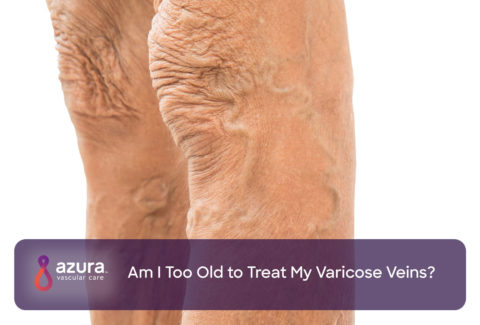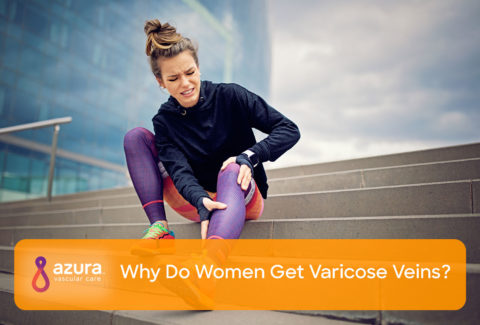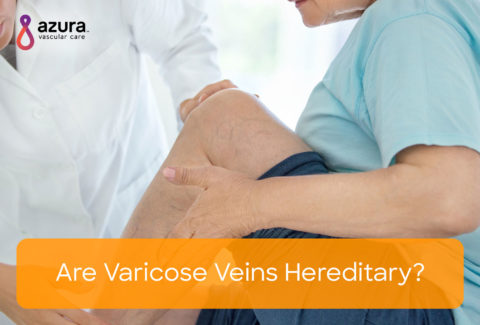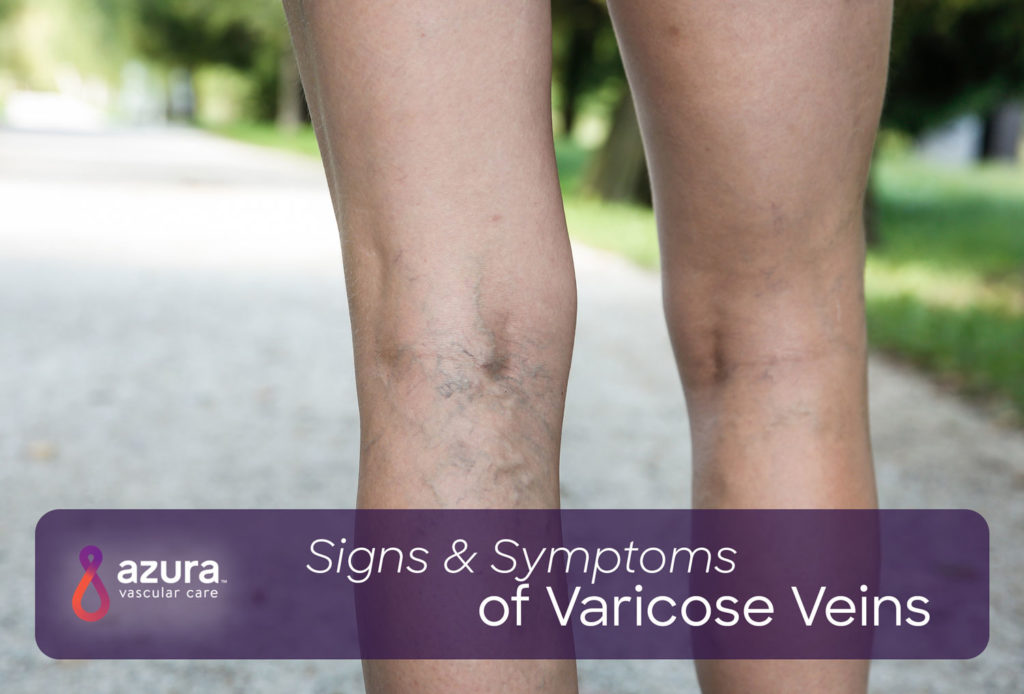
Do your legs sometimes feel heavy and achy? Do some of the veins on your legs appear swollen and twisted? If so, you may be experiencing varicose veins. With approximately 30% of Americans living with varicose veins, this condition is very common, especially in women. (i)
Read on to learn more about the signs and symptoms of varicose veins.
What Are Varicose Veins?
Veins are a part of your body’s circulatory system. They carry blood from your body’s tissues back to your heart where it picks up oxygen. From there, your arteries carry the oxygenated blood back to your body’s tissues. (ii)
Your veins have one-way valves that keep the blood flowing toward your heart. If the valves are damaged or weakened, rather than flowing back towards your heart blood can back up and pool in your veins, causing them to swell. Veins that are enlarged and swollen enough to be seen are known as varicose veins. These twisted and bulging veins appear most commonly on legs, though they can appear anywhere on your body.
There is a smaller version of varicose veins known as spider veins, which are enlarged capillaries close to the surface of the skin. Capillaries are tiny, thin-walled veins that act as a bridge between your arteries and your veins. Spider veins get their name honestly—they may look like a spider web or branches of a tree on your skin.
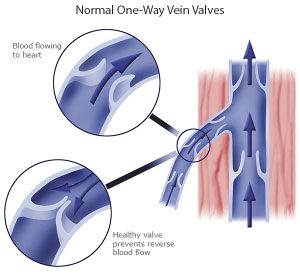
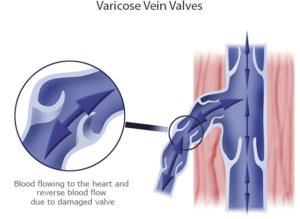
Varicose Vein Risk Factors
Varicose veins don’t discriminate—nearly anyone at any age can develop them. There are certain factors that increase your chances of developing varicose veins. These risk factors include:
- Family history – If you have family members with varicose veins, your risk for having them increases.
- Standing or sitting too long – Staying in one position for a long time — particularly if you are standing or your legs are crossed or bent — may force the veins in your legs to work harder to pump blood back to your heart. If you have a job that requires you to sit or stand for long periods of time, your risk of developing varicose veins is higher.
- Being overweight – Carrying extra weight can put extra pressure on your veins, which may increase the likelihood that you develop varicose veins.
- Pregnancy – During pregnancy, your growing baby puts pressure on your abdomen and on the veins in your legs. Many women find the varicose veins they develop during pregnancy go away within 3 to 12 months after giving birth.
- Aging – As the number of candles on your birthday cake increases, so too does your chance of developing varicose veins. This is typically caused by normal “wear and tear” of aging that may cause your veins to weaken.
- Gender – Women tend to get varicose veins more often than men. This is believed to be because of hormonal changes that occur during puberty, pregnancy, and menopause.
- Previous leg injury – If your leg sustained an injury at some point, the veins may be weakened in their ability to move blood back to your heart. Former damage to the veins in your legs increases your chances of developing varicose veins. (iii)
If you have one or more risk factors, it is important to check your body for early signs of varicose veins on a regular basis.
Signs of Varicose Veins
Swollen, twisted veins aren’t the only indication that you have varicose veins. Other signs and symptoms of varicose veins include:
- Large, bluish or purple-appearing bulging veins that you can see under the surface of your skin
- Swelling in your ankles and feet
- Painful or achy legs that feel “heavy”
- Muscle cramping in your legs—particularly at night
- Itchy legs, especially on your lower leg and ankles
- Burning or throbbing sensations in your legs
- Discolored patches of skin around the area where you have varicose veins
You may find your varicose vein symptoms worsen in warmer weather (iv), or if you’ve been standing for a long period of time. Your symptoms may improve if you rest and elevate your legs.
Some people with varicose veins develop a rash known as stasis dermatitis. It is important that you speak to a healthcare professional if you develop cracked, itchy skin around your varicose veins. If left untreated, varicose veins rash could develop into venous leg ulcers.
If you think you have varicose veins, the next step is to talk to your doctor for a diagnosis.
Early Warning Signs of Varicose Veins
In order to detect varicose veins early on, you’ll want to check your body regularly. Before the tell-tale bulging and swollen veins appear, your initial symptoms may be misdiagnosed as dermatological problems, since varicose veins may cause skin discoloration, give an unnatural shine to the skin and/or cause thickening or hardening of your skin. (v)
Other early warning signs of varicose veins include:
- Light red spots on your lower legs. These spots may indicate that you have venous insufficiency, increasing your risk of developing varicose veins at some point.
- Your legs hurt a little. Notice a dull aching in your legs? This could be an early sign of varicose veins.
- Dark, visible veins close to the surface of your skin. Individuals who have more visible veins have a higher likelihood of varicose veins.
- Swollen feet at the end of the day. If your feet are swollen at the end of each day, this may indicate that you are at higher risk of getting varicose veins.
- Even without these early warning signs, there is a chance you may develop varicose veins, particularly if you have a family history or other risk factors.
Although varicose veins themselves generally do not lead to long-term health problems, it is important to take care of them and manage your symptoms. In some cases, varicose veins may worsen over time. Know that help is out there. Talk to your doctor for a formal diagnosis.
To find out everything you need to know about varicose veins, browse our website to find answers to common varicose vein questions, or find a varicose veins treatment center near you.
Sources:
(i) I Lin, F., Zhang, S., Sun, Y., Ren, S., & Liu, P. (2015). The management of varicose veins. International Surgery. 100, 185-189. https://www.ncbi.nlm.nih.gov/pmc/articles/PMC4301287/
(ii) Institute for Quality and Efficiency in Health Care (2010 Mar 12). How does the blood circulatory system work? Informed Health Online [Internet]. https://www.ncbi.nlm.nih.gov/books/NBK279250/ (Updated: 1/31/2019 Accessed 2/26/2019).
(iii) Selçuk Kap?s?z, N., Uzun Kulao?lu, T., Fen, T., & Kap?s?z, H. F. (2014). Potential risk factors for varicose veins with superficial venous reflux. International Journal of Vascular Medicine, 531689.
(iv) Institute for Quality and Efficiency in Health Care (2008 Feb 20). Varicose veins: Overview. Informed Health Online [Internet] https://www.ncbi.nlm.nih.gov/books/NBK279247/ (Updated 7/13/2016. Accessed 2/25/2019).
(v) Mujadzic, M., Ritter, E.F., & Givens, K.F.(2015)A novel approach for the treatment of spider veins. Anesthetic Surgery Journal, 35(7): NP221-NP229. https://www.ncbi.nlm.nih.gov/pmc/articles/PMC4551823/
